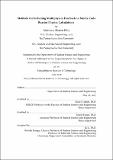| dc.contributor.advisor | Kord S. Smith and Benoit Forget. | en_US |
| dc.contributor.author | Ellis, Matthew Shawn | en_US |
| dc.contributor.other | Massachusetts Institute of Technology. Department of Nuclear Science and Engineering. | en_US |
| dc.date.accessioned | 2017-12-05T16:25:25Z | |
| dc.date.available | 2017-12-05T16:25:25Z | |
| dc.date.copyright | 2017 | en_US |
| dc.date.issued | 2017 | en_US |
| dc.identifier.uri | http://hdl.handle.net/1721.1/112381 | |
| dc.description | Thesis: Ph. D., Massachusetts Institute of Technology, Department of Nuclear Science and Engineering, 2017. | en_US |
| dc.description | This electronic version was submitted by the student author. The certified thesis is available in the Institute Archives and Special Collections. | en_US |
| dc.description | Cataloged from student-submitted PDF version of thesis. | en_US |
| dc.description | Includes bibliographical references (pages 314-321). | en_US |
| dc.description.abstract | The ability to model and simulate nuclear reactors during steady state and transient conditions is important for designing efficient and safe nuclear power systems. The accurate simulation of a nuclear reactor is particularly challenging because the multiple physical processes within the reactor are tightly coupled, which requires that the numerical methods used to resolve each physical process can accurately and efficiently transfer and utilize data from other applications. Monte Carlo methods are desirable for solving the neutron transport equation required in reactor analysis because of the inherent accuracy of the method, but the Computational Solid Geometry (CSG) representation of the physical geometry makes it difficult to accurately and efficiently perform multiphysics reactor analyses with other applications that utilize finite element or finite volume representations. To address this limitation, a multiphysics coupling framework that minimizes the need for spatial discretization in the Monte Carlo geometry is presented in this thesis. The coupling framework uses Functional Expansion Tallies to transfer multiphysics information from the Monte Carlo application to other multiphysics tools. Additionally, the coupling framework uses a modified method for transporting neutrons through spatially continuous total macroscopic cross section distributions in order to incorporate continuous multiphysics feedback fields such as fuel temperature and coolant density into the Monte Carlo simulation. It has been shown that separable Zernike and Legendre Function Expansion Tallies can effectively reconstruct a continuous distribution of fission power density. Additionally, using a prototypical three-dimensional Light Water Reactor pin cell, the method used to transport neutrons through a continuously varying fuel temperature and coolant density distribution was shown to be 1.7 times faster than a comparable discretized simulation with volume-averaged properties, while still providing a high level of accuracy. Finally, in order to make the overall multiphysics coupling scheme useful for reactor analyses, a novel spatially continuous depletion methodology was developed and investigated. With the spatially continuous depletion methodology, number densities can be represented as a linear combination of polynomials, and those polynomial representations can be integrated through time to predict reactor operation. The spatially continuous depletion methodology was able to accurately predict the eigenvalue and number density distributions in a two-dimensional LWR pin cell depletion containing Gd-157 from a 2 weight percent GdO2 and seven other nuclides in the depletion matrix. Analyses of the spatially continuous depletion methodology showed that significant reductions in the number of tallied values could be achieved if polynomial representations were optimized for each nuclide reaction rate. From the depletion simulations in this thesis, a 23% reduction in the required number of reaction rate tallies compared to a lower-fidelity, 10 radial ring pin discretization was shown to be achievable with nuclide polynomial optimization. In addition to showing potential for reductions in tally memory and computational requirements, the spatially continuous depletion simulation was shown to be equal in computational performance to a discrete simulation with 10 radial rings and 8 azimuthal cuts, while providing a much higher level of spatial fidelity in number density concentrations. | en_US |
| dc.description.statementofresponsibility | by Matthew Shawn Ellis. | en_US |
| dc.format.extent | 321 pages | en_US |
| dc.language.iso | eng | en_US |
| dc.publisher | Massachusetts Institute of Technology | en_US |
| dc.rights | MIT theses are protected by copyright. They may be viewed, downloaded, or printed from this source but further reproduction or distribution in any format is prohibited without written permission. | en_US |
| dc.rights.uri | http://dspace.mit.edu/handle/1721.1/7582 | en_US |
| dc.subject | Nuclear Science and Engineering. | en_US |
| dc.title | Methods for including multiphysics feedback in Monte Carlo reactor physics calculations | en_US |
| dc.type | Thesis | en_US |
| dc.description.degree | Ph. D. | en_US |
| dc.contributor.department | Massachusetts Institute of Technology. Department of Nuclear Science and Engineering | |
| dc.identifier.oclc | 1011423433 | en_US |
